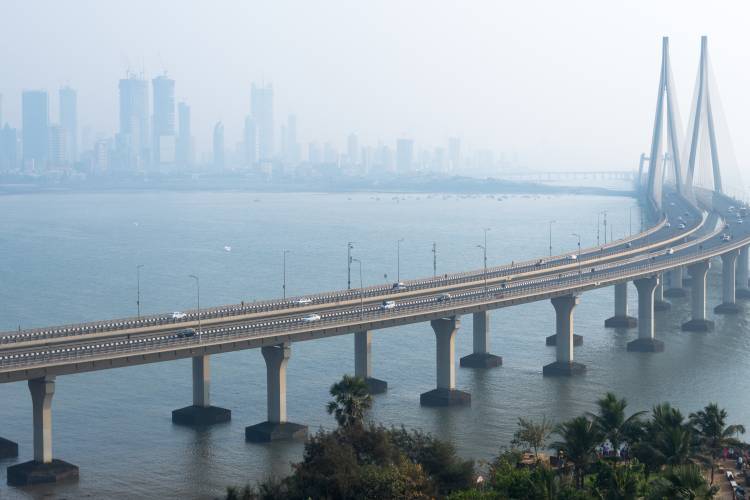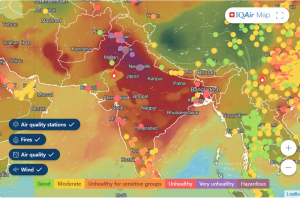
Air pollution in Mumbai: Mumbai experienced a dip in air quality last month, with the Air Quality Index exceeding 200 in several parts of the city. As per the Central Pollution Control Board, the AQI improved slightly to 150 on Saturday, just below the red mark. It is hardly surprising that Mumbai, India’s financial capital, ranks among the world’s most polluted cities, given that India is home to 39 of the top 50. In fact, last week, Mumbai held the position as the second most polluted city globally.
Several factors, including a delayed monsoon withdrawal, booming real estate development, and a rush to enhance transportation systems post-pandemic, have exacerbated the city’s air quality, making it a virtual gas chamber. Consequently, there has been a significant increase in respiratory ailments, with medical professionals reporting a 25% rise in outpatient cases related to such illnesses.
READ | Income tax data reveal soaring income inequality
Air pollution is the second leading risk to human health in India. Beyond the immediate health risks, high pollution levels cost Indian businesses approximately $150 billion annually and reduce consumer spending by $22 billion, as highlighted in the World Air Quality Report 2022. The IT sector, a crucial contributor to the country’s economy, loses $1.3 billion annually due to reduced productivity caused by pollution. The national capital region’s burgeoning IT industry alone stands to lose over $2.5 billion annually unless the city’s air quality improves.
AQI as of 31 October 2023

The primary culprits behind India’s air pollution are vehicular emissions, power generation, industrial waste, biomass burning for cooking, construction activities, and sporadic events like crop burning around Diwali. In rural areas, organic material combustion is a major pollutant. These factors, combined with other variables, position India as the third-largest global producer of greenhouse gases, trailing only China and the US. The Air (Prevention and Control of Pollution) Act, introduced in the early 1980s, has unfortunately not delivered the desired results due to weak enforcement.
Air pollution in Mumbai
With upcoming elections, there is a state-led push to expedite projects, including the Metro transit system, to alleviate city congestion and reduce pollution. Moreover, there has been a surge in construction activities, with real estate projects nearly doubling compared with financial year 2020-21. Factors such as delayed monsoon combined with anticyclonic wind patterns have enveloped the city in dust and smog. However, construction remains the main offender. Construction materials, when airborne, can cause severe health issues like silicosis, an incurable condition. Consequently, air purifier sales have seen a spike.
Children are particularly vulnerable to the health effects of air pollution. Air pollution can damage their lungs and brains, and it can also increase their risk of developing respiratory infections, asthma, and other chronic diseases. Air pollution can also affect pregnant women and their babies, leading to premature birth, low birth weight, and birth defects.
The cost of air pollution to India is staggering, both economically and in terms of human health. The country must take urgent action to reduce air pollution levels and protect its people. This will require a concerted effort from all stakeholders, including the government, businesses, and individuals.
Reversing the damage
South Asia is a major air pollution hotspot, with 60% of its inhabitants residing in areas exceeding the WHO’s least stringent air quality standards. These conditions contribute to over two million premature deaths annually. The World Bank’s study, ‘Striving for Clean Air: Air Pollution and Public Health in South Asia,’ advocates for regional cooperation. Collaboration would be more cost-effective than isolated efforts. If South Asian regions work together to implement viable solutions, average exposure could drop to 17 micrograms/m³ by 2030.
For instance, household biomass burning in parts of the Indo-Gangetic plain accounts for a third of the area’s air pollution. Promoting clean cooking methods should be a top priority.
Mumbai’s local municipality has taken steps to mitigate some of the damage. Twenty-seven initiatives, including sprinklers, vehicle tire-washing stations, and proper disposal of construction materials, have been introduced, mainly focusing on construction sites. However, addressing dust is merely the beginning. A collective effort is required to truly cleanse Mumbai’s skies. While dust is the most noticeable pollutant, others, like industrial chemicals and unauthorised garages near slums, also play a part.
Mumbai’s authorities emphasise that their pollution challenges differ from those of the national capital, Delhi. The distinction lies in their control over pollution sources. BMC has pledged to closely monitor major polluters, such as Bharat Petroleum Corporation, Hindustan Petroleum Corporation, Rashtriya Chemicals and Fertilisers, and Tata Power, over the coming month, vowing to take decisive action as needed.

